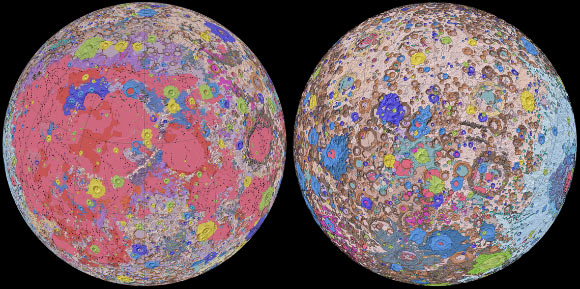A team of researchers from the U.S. Geological Survey, the Lunar and Planetary Institute and the South Dakota School of Mines and Technology has released a seamless, globally consistent, 1:5,000,000-scale geologic map of the Moon.

Orthographic projections of the Unified Geologic Map of the Moon showing the geology of the Moon’s near side (left) and far side (right) with shaded topography from the Lunar Orbiter Laser Altimeter (LOLA). Image credit: U.S. Geological Survey / Lunar and Planetary Institute / South Dakota School of Mines and Technology / NASA / JAXA.
The new digital map, called the ‘Unified Geologic Map of the Moon,’ will serve as the definitive blueprint of the Moon’s surface geology for future human missions and will be invaluable for the international scientific community, educators and the public-at-large.
“This map is a culmination of a decades-long project,” said lead author Dr. Corey Fortezzo, a geologist at the U.S. Geological Survey.
“It provides vital information for new scientific studies by connecting the exploration of specific sites on the Moon with the rest of the lunar surface.”
To create it, Dr. Fortezzo and colleagues used information from six Apollo-era regional maps of the Moon.
Elevation data for the Moon’s equatorial region came from stereo observations collected by the Terrain Camera on JAXA’s Selenological and Engineering Explorer (SELENE) mission.
Topography for the north and south poles was supplemented with data from the Lunar Orbiter Laser Altimeter (LOLA) on board NASA’s Lunar Reconnaissance Orbiter.
The historical maps were redrawn to align them with the modern data sets, thus preserving previous observations and interpretations.
The team also developed a unified description of the stratigraphy, or rock layers, of the Moon.
This resolved issues from previous maps where rock names, descriptions and ages were sometimes inconsistent.
“While this release includes a PDF of the unified map for printing on a large-format plotter, the real benefit is the release of the digital GIS database to support further scientific study at multiple scales,” said Dr. Trent Hare, an astrogeology cartographer at the U.S. Geological Survey.
“Making a map like this is not easy. It was a huge effort for our team to complete this new map and make it seamless,” said U.S. Geological Survey Astrogeology Director Dr. Justin Hagerty.
“Much of the historical mapping was performed by various groups and at regional scales. Slightly different methods were used, so that maps of the same feature that had been mapped by different groups would not match.”
“People have always been fascinated by the Moon and when we might return,” said U.S. Geological Survey Director and former NASA astronaut Jim Reilly.
“So, it’s wonderful to see the said U.S. Geological Survey create a resource that can help NASA with their planning for future missions.”
The researchers presented the new map March 19, 2020 at the 51st Lunar and Planetary Science Conference.
_____
C.M. Fortezzo et al. 2020. Release of the Digital Unified Global Geologic Map of the Moon at 1:5,000,000-Scale. LPSC 51, abstract # 2760







